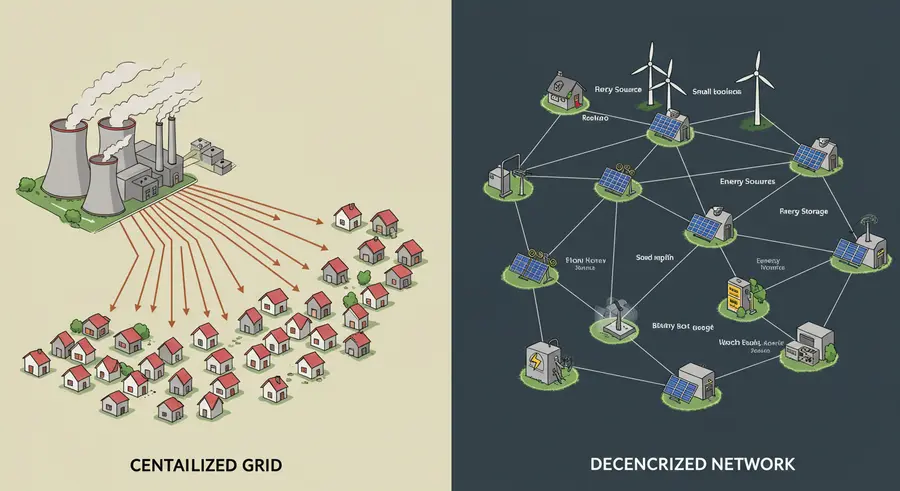Appearance
Power to the People: How Decentralized Energy & P2P Trading are Rewiring the Grid ⚡️💡
Our world runs on energy, but for far too long, our power systems have been stuck in a centralized, top-down model. Think of it: massive power plants sending electricity one way, through a complex grid, to millions of homes and businesses. This traditional setup has its issues – it's vulnerable to disruptions and not always the most efficient. But what if there was another way? A way that puts power directly into the hands of communities?
Welcome to the revolution of decentralized energy networks and peer-to-peer (P2P) energy trading. This isn't just a futuristic concept; it's happening now, and it's fundamentally changing how we think about power.
The Shift: From Centralized to Community Power
Imagine an energy system where power isn't just generated by a few giants, but by many smaller, local sources: solar panels on rooftops, small wind turbines, and even community battery storage units. This is the essence of a decentralized energy network.
Here's a simple way to visualize the change:

Instead of a single, large power plant dominating the landscape, we see a vibrant, interconnected web. This distributed approach makes our energy systems more resilient to outages and far better at integrating diverse renewable energy sources.
Unlocking Local Power with Peer-to-Peer Trading
The real magic happens when these local energy sources can talk to each other and trade power directly. That's where Peer-to-Peer (P2P) energy trading comes in.
Think about it:
- Your neighbor has extra solar power generated on a sunny afternoon.
- You need a bit more power to charge your electric vehicle.
- Instead of both going through a central utility, you trade directly!
This concept might sound complex, but technologies like blockchain are making it simple and secure. Blockchain creates a transparent, tamper-proof record of every transaction, ensuring trust without needing a middleman. It enables a new level of energy democracy, empowering individuals and communities to manage their own energy flow.
Here’s a simplified look at how a P2P energy transaction might be recorded:
{
"transaction_id": "tx_789abcde",
"seller": "Prosumer_Node_Alpha",
"buyer": "Consumer_Node_Beta",
"energy_amount_kwh": 5.2,
"price_per_kwh": 0.15,
"timestamp": "2025-07-15T09:45:00Z",
"status": "completed"
}This transparent ledger, powered by blockchain, ensures that every watt exchanged is accounted for.
The AI Advantage: Smarter Trading, Stronger Grids
Beyond simply facilitating transactions, Artificial Intelligence (AI) and Machine Learning (ML) are supercharging these decentralized networks. AI algorithms can analyze huge amounts of data – from local weather patterns and consumption habits to real-time energy prices – to optimize trading decisions.
This means:
- Predictive Maintenance: AI can foresee equipment failures in local microgrids before they happen, minimizing downtime.
- Demand-Response Optimization: AI can smartly adjust energy flows to meet demand spikes, ensuring grid stability and reducing waste.
- Automated Energy Management: AI can automate buying and selling decisions in P2P markets to get the best prices and utilize local renewables most effectively.
Companies are already using ML to predict wind farm output and optimize battery storage, demonstrating significant cost savings and efficiency gains.
The Road Ahead
The shift to decentralized energy and P2P trading isn't without its challenges. We need to tackle issues like data quality, the complexity of integrating new tech with old infrastructure, and ensuring fair access for everyone. But the benefits – increased resilience, improved efficiency, and true energy independence – are far too significant to ignore.
This is more than just a technological upgrade; it's a fundamental rewiring of our energy future. By empowering communities to generate, manage, and trade their own power, we're building a grid that's not just green, but truly smart and democratic. Energy independence through intelligent design – that's the future we're building, one watt at a time. 🌿📊